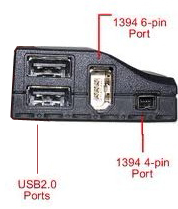Data Recovery -> IEEE1394
Storage devices
Types of HDD
Partition Series
Linux
Operating Systems
Windows
IEEE1394
 IEEE1394 is the serial standard developed by Apply Inc with Chinese name of Firewire. Similar to USB, IEEE1394 supports Hot-plug to supply power for external devices and save the own power supply of external devices allowing connection to diverse devices and synchronous data transmission.
IEEE1394 is the serial standard developed by Apply Inc with Chinese name of Firewire. Similar to USB, IEEE1394 supports Hot-plug to supply power for external devices and save the own power supply of external devices allowing connection to diverse devices and synchronous data transmission.IEEE1394 has two transmission methods: Backplane and Cable. The minimum speed of Backplane is even higher than USB 1.1 by enjoying speed of 12.5 Mbps, 25 Mbps and 50mbps which can be used in most broad bandwidth. Cable is a mode possessing extremely high speed with speed of 100 Mbps, 200 Mbps and 400 Mbps among which high quality data movie could be transmitted under 200 Mbps without compression.
As upgraded edition of 1394, 1394b is the only family network standard specially designed for multimedia such as video, audio, controlling and computer to have realized high performance family network with low cost and safe CAT5, etc. 1394a has provided products since 1995 and 1394b is the downward compatibility expansion of 1394a. 1394a is able to offer over 800 Mbps transmission speed. Though there isn’t any 1394b product now on market, it will be presented for user before long.
Compared with USB interface in its USB 1.1 stage, 1394a interface enjoys great advantage in light of speed which becomes less obvious after the release of USB2.0. Many mainstream computers don’t have 1394 interface and extra charge will be consumed for relevant interface card if user wants to use 1394a interface. Currently, seldom do is there any external optical storage device that purely supports 1394 interface with most devices supporting both 1394 and USB interfaces.
The design plus high speed transmission rate of IEEE1394 allows user to edit electronic image document directly through computer, sparing plenty of disk space. Prior to the emergence of IEEE1394, special hardware is required to edit electronic image by downloading movies into hard disk. However, as the hard disk becomes cheaper and cheaper, high speed IEEE1394 replaced USB 2.0 to be the best interface connecting computer hard disk externally.
Theoretically, 1394A supports 4.5m maximum wire length and 63 devices at most with standard transmission rate of 100Mbps normally.
[Related terms]
IEEE1394a (FireWire 400)
IEEE1394a 6Pin(left)and IEEE1394a 4Pin(right)connector
IEEE1394b (FireWire 800)
IEEE1394c (FireWire S800T)
Applications of IEEE1394
Aircraft, automobile, wind power turbine, networking over firewire, IIDC and DV, etc.
Editions
IEEE1394a-2000(FireWire 400)
It is the new specification after improving several places which is almost the same as IEEE1394-1995. To differ it from IEEE1394, IEEE1394-1995 is also referred to as FireWire 400 or .a in industrial use.
IEEE1394b-2002(FireWire 800)
This specification and corresponding products allow a transfer rate of 786.432 Mbit/s full-duplex via a new encoding scheme termed beta mode. It is backwards compatible to the slower rates and 6-circuit alpha connectors of FireWire 400.
IEEE1394c-2006(FireWire S800T)
IEEE1394c-2006 was published on June 8, 2007. It provided a major technical improvement, namely new port specification that provides 800 Mbit/s over the same 8P8C (Ethernet) connectors with Category 5e cable, which is specified in IEEE 802.3 clause 40 (gigabit Ethernet over copper twisted pair) along with a corresponding automatic negotiation that allows the same port to connect to either IEEE Std 1394 or IEEE 802.3 (Ethernet) devices.Though the potential for a combined Ethernet and FireWire 8P8C port is intriguing, as of November 2008, there are no products or chipsets which include this capability.
S1600 and S3200
1394 Trade Association, promotion group of IEEE1394 declared that new expanded specification S1600 and S3200 will be available at the end of 2008. The 1.6 Gbit/s and 3.2 Gbit/s devices use the same 9-circuit beta connectors as the existing FireWire 800 and will be fully compatible with existing S400 and S800 devices. It will compete with the forthcoming USB 3.0. S1600 (Symwave) and S3200 (Dap Technology) development units have been made, with the latter promising a consumer version by late 2010.